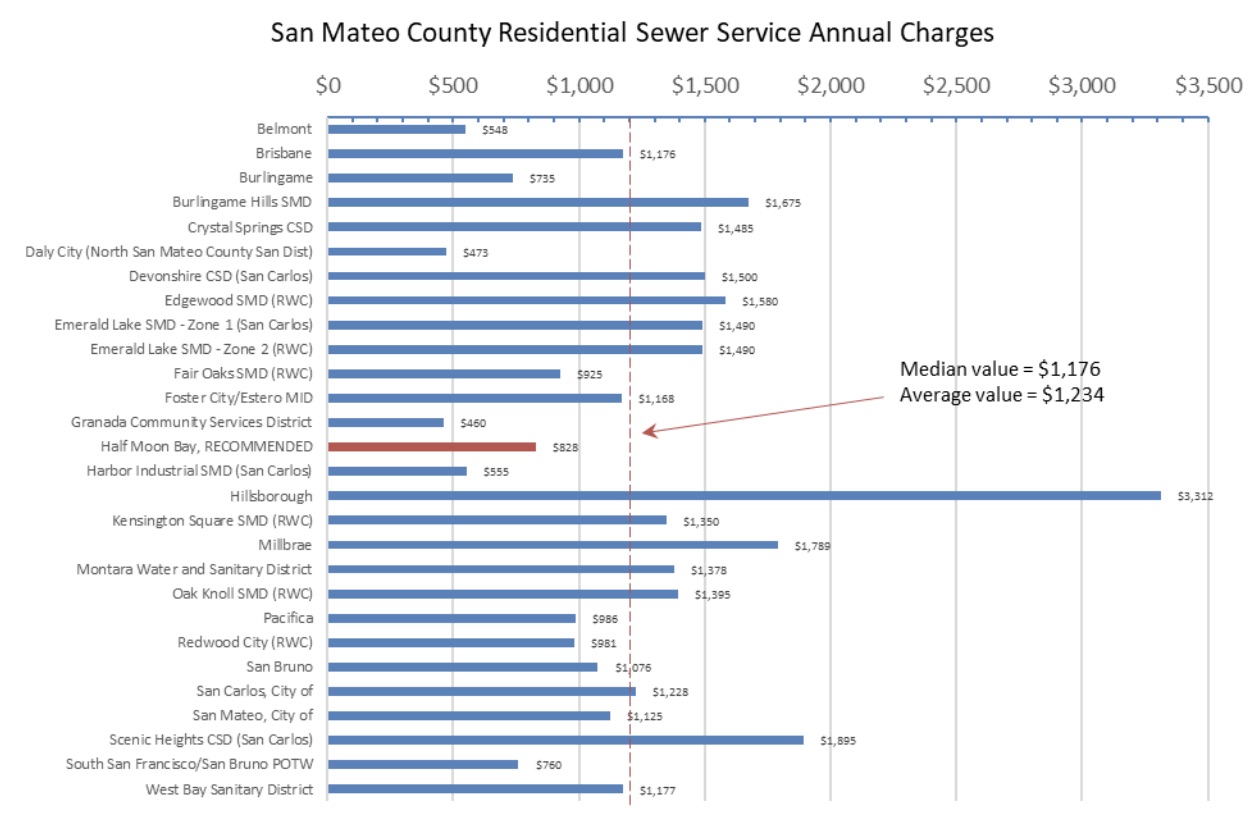|
Getting your Trinity Audio player ready...
|
VIDEO. The Half Moon Bay City Council and staff worked through the protest hearing process at the 6/2/2020 City of Half Moon Bay Council Meeting.
Watch the Whole Meeting >>>>
Note at 1:32 Mayor Adam Eisen explains how flat rates will work.
Two Flat Rates 1. Mobile Homes and Seniors 2. Single Family and Multi-Family
80% of sewer authorities use flat rate to create consistent revenue and equitiblity.
Here is the agenda for this item
RECOMMENDATION: In the following order, it is recommended the City Council:
1) receive and adopt the final draft of the “2020 Sewer Service Charges Study”, dated April 7, 2020 prepared by Municipal Financial Services (MFS);
2) open a public hearing and receive public comment;
3) request submission or withdrawal of Proposition 218 protest letters from the public;
They must keep Proposition 218 in mind, legally. Proposition 218 outlines the public notice process for rate increases.
4) close the public hearing and allow the City Clerk, or her designee, to tabulate the final Proposition 218 protest letter count;
5) receive and accept a verbal report from the City Clerk, or her designee, on ballot tabulation results;
6) adopt a resolution approving sewer rate adjustments; and
7) conduct a public hearing and introduce on first reading an ordinance amending Chapter 13.36, and adding Chapter 13.38 to the Half Moon Bay Municipal Code.
FISCAL IMPACT:
The purpose of the rate adjustment is to create a financially sustainable Sewer Enterprise Fund. Over the last five years, fixed sewer system costs have continued to grow with costs exceeding revenues generated by the current rates. Over the last three years, the City has found it necessary to utilize emergency/capital reserve funds for fixed operational costs. In FY 2019-20, $2,006,000 was transferred to the operating fund from the capital reserve fund.
ENVIRONMENTAL REVIEW:
As set forth in California Code of Regulations Section 15273, the California Environmental Quality Act does not apply to the establishment, modification, structuring, restructuring, or approval of rates and other charges by a public agency provided the purpose is to maintain and operate services within the existing service area boundary.
SEWER SYSTEM OVERVIEW:
The City’s collection system includes approximately 35 miles of gravity sewer lines, three (3) pump stations and three (3) force mains. Wastewater from residences, businesses, schools, restaurants and other buildings and uses is conveyed through sewer mains owned by the City of Half Moon Bay to the sewer treatment plant operated by Sewer Authority Mid-Coastside (SAM). The City collection system serves residences, businesses, and public uses from Frenchman’s Creek on the north to Miramontes Point Road on the south. The City primarily serves properties located in the incorporated area; however, the City serves some adjacent areas outside city limits including the Moonridge Housing Development.
The City, Granada Community Services District (Granada), and Montara Water and Sanitary District (Montara) formed the Sewer Authority Mid-Coastside via an exercise of Joint Powers Authority (JPA). SAM facilities include a conventional wastewater treatment plant (located at 1000 N. Cabrillo Highway, Half Moon Bay) and the Intertie Pipeline System (IPS), which conveys flows through pumping facilities, force mains, and interceptor pipelines from Granada and Montara service areas to the wastewater treatment plant. Under the current JPA, the City is responsible for paying a proportional share of the plant flow for operations, maintenance, and capital costs of the wastewater treatment plant. In FY 2019-20, the City’s proportional share of operations and maintenance was set at 56 percent. In 2017, the City filed for Declaratory Relief regarding language in the JPA related to member agencies’ respective obligations for paying for capital projects (notably the IPS). The parties and City agreed to enter into mediation and have been actively engaged in settlement discussions.
The regional wastewater treatment plant was originally constructed in the late 1970s, following the formation of the JPA. The treatment plant was substantially upgraded in late 1999/2000 and has sufficient capacity to receive and treat anticipated wastewater flows. The treatment plant, due substantially to deferred maintenance, is in need of major maintenance and capital repair which have been estimated between $30 and $40 million. This rate study includes funding for capital repair and replacement on either a financed or pay-as-you-go scenario. The rates include approximately $2.4 million in combined annual contributions from the City, Granada, and Montara.
The IPS was constructed in the late 1970s and is, for the most part, comprised of original system components. In 2017, the Granada Force Main suffered a major break and resulted in a significant sanitary sewer spill (SSO). Two smaller SSO events occurred on other sections of the Granada Force Main. As a result, SAM completed replacement of approximately 5,700 feet of the Granada Force Main at a cost of almost $2 million. SAM recently commenced work on an additional 1,500 feet of the Granada Force Main. SAM was fined, (and member agencies proportionately paid) approximately $600,000, by the Regional Water Board for the 2017 SSO events. SAM was subsequently sued by the Ecological Resource Foundation (ERF). In addition to some cash considerations, the settlement of this suit included commitment to a series of replacements of the IPS over the next five years totaling an estimated almost $9 million. Total IPS repair and replacement is estimated between $20 and $25 million.
SEWER ENTERPRISE FUND OVERVIEW:
The City’s Sewer Fund is a government enterprise fund. An enterprise fund is a self-supporting government fund that provides a specialized service. In this instance, City sewer services represent the specialized service; the Sewer Fund is the City’s only enterprise fund. The Sewer Fund is shown in the City’s Annual Operations Budget as two separate accounts: Fund 05 (Operating Fund); and 06 (Sewer Capital Fund). The separation exists solely to separately account for operations expenses and capital expenses.
Ninety-nine percent (99%) of sewer system (utility) revenues is derived directly from rates charged to the users of the sewer system. Per state law, sewer service charges are permitted to recover only revenues sufficient to adequately fund sewer utility operations, maintenance, and capital replacement expenditures including maintenance of emergency and capital reserves. As noted, the City’s sewer service charges include not only the operation and maintenance of the City collection system, but also the proportional costs of operating and maintaining the Sewer Authority Mid-Coastside (SAM) (including the treatment plant and intertie pipeline system).
Operations and maintenance costs for sewer services have increased significantly over the last three years. Between FY 2015-16 ($2,299,898) and FY 2019-20 ($4,131,899), Half Moon Bay’s proportion of SAM budgeted costs alone have almost doubled. Additionally, the City’s share of the costs has increased by almost 10 percent over the last five years. SAM related increases are attributable to a number of factors including the need to provide sufficient staffing, address deferred maintenance, pay for sewer spill related costs, and account for the rapidly increasing cost of materials and labor for capital construction and maintenance.
The City’s collection system operating costs have also risen in response to statutory oversight obligations, addressing long deferred maintenance, providing oversight of the operations and maintenance, and also to account for the rapidly increasing cost of materials and labor for capital construction and maintenance. The City Council recently awarded a construction contract for the Ocean Colony Pump Station and Force Main Project (app. $2.1 million). This project is needed to replace aging infrastructure necessary to protect the environment and limit liability and is indicative of the cost of maintenance and replacement of sewer infrastructure. Additional capital maintenance and repair will continue to be needed to protect the environment, limit liability, and meet statutory obligations. While the City is proactively managing and maintaining its sewer assets, portions of the inground pipes are 70-80 years old and approaching normal life expectancy. The cost of SAM contract services for sewer cleaning and emergency response has increased approximately 33-percent for FY 20-21.
The last rate increase for City sewer customers was effective July 1, 2014, based upon a rate study approved by the City Council in 2012. The increases covered rates for FY 2012-13 and FY 2013-14. This adjustment followed a rate increase approved in 2010 which increased rates in FY 2010-11 and FY 2011-12. Granada and Montara are subject to the same fixed costs issues and have each increased rates during this period of time. Montara is currently conducting its public hearing protest process that includes three years of nine percent annual rate increases (effective on July 1, 2020). Many San Mateo County/Peninsula agencies have or will be considering rate adjustments to address increasing fixed costs and environmental compliance.
The New Now ~ Virtual Remote Public Agency Meetings
- streamed live on Comcast Channel 27 and Pacific Coast TV website
- the City’s website online (via Granicus)
- and on Facebook Live
- one in English (City of Half Moon Bay FB Page)
- one in Spanish (City of Half Moon Bay Recreation FB Page)
- Recorded by Pacific Coast TV (PCTV)
 ing – (650) 477-4963 (English) and (650) 445-3090 (Spanish).
ing – (650) 477-4963 (English) and (650) 445-3090 (Spanish).HMB City Council Agendas and Virtual Meeting Link
HMB City Calendar










